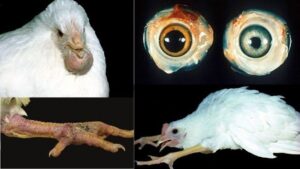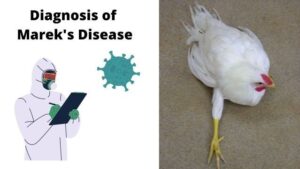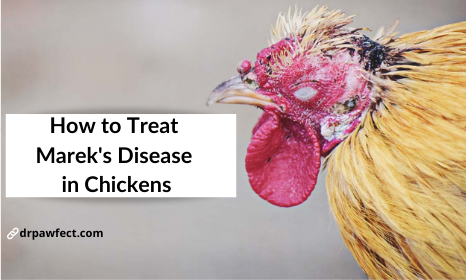𝐌𝐚𝐫𝐞𝐤’𝐬 𝐃𝐢𝐬𝐞𝐚𝐬𝐞 𝐢𝐧 Backyard Poultry : 𝐒𝐲𝐦𝐩𝐭𝐨𝐦𝐬, 𝐚𝐧𝐝 𝐓𝐫𝐞𝐚𝐭𝐦𝐞𝐧𝐭𝐬
Nowadays one of the fastest growing agribusiness in India is poultry production, an efficient and relatively low carbon-footprint means of producing the additional animal protein required for escalating human population . India is the world’s third largest egg producer , but infectious diseases impede its sustainability. Marek’s disease (MD), a lymphomatous and neuropathic viral disease of fowl, accounts for about $1-2 billion annual economic loss to this industry . Marek’s disease virus (MDV), belongs to genus Mardivirus, alphaherpesvirinae subfamily of family Herpesviridae, is enveloped, icosahedral and single linear double standard DNA virus. Gallid herpesvirus-2 [serotype 1; all pathogenic (i.e. cell associated and oncogenic) strains and its attenuated variants], Gallid herpesvirus-3 [serotype 2; avirulent and non-oncogenic strains] and Meleagrid herpesvirus-1 [serotype 3; avirulent herpesvirus of turkeys] are well-established three serotypes of MDV . It may occur in acute MD form, classical MD (neural form), ocular form (Grey or pearl eye), Cutaneous (red leg syndrome), transient paralytic and muscular form . Major complications associated with acute MD are marked enlargement of spleen, liver, kidney, proventriculus, lung and gonad with diffuse lympomatous involvement while enlargement of peripheral nerve such as brachial and sciatic nerve observed in classical MD which in turn consequence to spastic paralysis of wings and legs (Split leg stance or Athletic foot syndrome). Ocular form (blindness) observed in poultry due to mononuclear cell infiltration in iris . Oncogenic transformation of T cells, involvement of lymphoid tissues, peripheral nerves and visceral organs and complex pathogenesis usually leads to death of the affected birds . The transmission of MDV occurs by direct or indirect contact, apparently by the airborne route. The epithelial cells in the keratinising layer of the feather follicle replicate fully infectious virus, and serve as a source of contamination of the environment. It may survive for months in poultry house litter or dust. Dust or dander from infected chickens is particularly effective in transmission. Once the virus is introduced into a chicken flock, regardless of vaccination status, infection spreads quickly from bird to bird.
Marek’s Disease in Chickens is a highly contagious viral disease that needs to be prevented to avoid huge economic loss in Poultry. If you are new to the poultry sector or didn’t hear the word Marek’s Disease ever before then this is the right place for you because here, I am going to enlist all information about Marek’s Disease in Chickens So let’s get started.
What is Marek’s Disease in Chickens
A highly contagious avian viral infection, characterized by T lymphocytes infiltration in many visceral organs and peripheral nerves. This infiltration leads to T-cell Lymphoma and peripheral nerve enlargement. History of bird, clinical signs, and gross necropsy are the standard criteria for diagnosis. Although no effective treatment is available, vaccines are the best way to prevent Marek’s Disease in Chickens.
What Causes Marek’s Disease in Chickens?
Marek’s Disease in Chickens is caused by a virus commonly known as Mareks Disease Virus ( MDV ). This virus belongs to the subfamily of Alphaherpesvirinae with the genus Mardivirus. There are three species of this genus. These species are known as serotypes or strains. The three serotypes of MDV are:
- Gallid alphaherpesvirus 2 (MDV serotype 1)
- Gallid alphaherpesvirus 3 (MDV serotype 2)
- Meleagrid alphaherpesvirus 1 (turkey herpesvirus, MDV serotype 3)
Out of these, the last one is used for making vaccines for Marek’s disease.
How Marek’s Disease is Transmitted?
As I mentioned earlier, Marek’s Disease is highly contagious and readily transmissible. The MDV matures in the follicles of the bird’s feathers. After that this virus sheds in the dander or dust. Dander is a flake of a bird’s skin. The MDV can survive in the litter houses of Poultry birds and remain viable during this period.
Chickens become infected with MDV by inhaling infected dust or dander that shed in the form of flakes of infected birds. Once the virus is within the body of birds, the infection continues to spread regardless of the vaccination status of poultry birds.
The virus invades the epithelial cells in the air spaces of the chicken’s lungs. This is the main reason for difficult breathing in Marek’s Disease in Chickens. In addition to the lungs, the MDV spreads to other parts of the body and has a tendency to be transported towards cutaneous sites such as the skin, and feather follicles, etc.
From there, MDV is shed into the environment via scales and feather debris from infected birds. The virus can remain infectious in the environment for up to 8 months. This is how Marek’s Disease transmit in Poultry birds. The transmission is horizontal.
Symptoms of Marek’s Disease in Chickens
The Symptoms of Mareks Disease in Chickens are highly variable and depend on various factors. As in Mareks disease, there is an enlargement of the peripheral nerves because of lymphocytes infiltration. This lymphoma spreads to different visceral organs. So there are 6 distinct syndromes that are indicators of Marek’s Disease in Chickens. These are
Classical Marek’s Disease or Neurolymphomatosis:
In classical Marek’s disease, the infected birds show some signs and symptoms that are
- Enlargement of crop
- Paralysis of one or more limbs due to vagus nerve involvement
- Difficult breathing
- Lesions on lungs, heart, kidneys, and peripheral nerves.
Acute Marek’s Disease:
Acute Mareks syndrome is an epidemic in progress because, after paralysis, the birds die in a short period of time. This type of disease affects 80% of the flock.
Ocular Lymphomatosis:
Lymphoid infiltration into the eyes; causes a change in iris color, pupil shape or size, partial or total blindness.
Cutaneous (skin) form:
Lymphoid infiltration into the skin; causes enlarged feather follicles, often scattered or clustered together, especially on the legs.
In general, the clinical signs and symptoms of Marek’s Disease in Chickens are:
- Paralysis of legs, neck, or feathers
- Change in eye color to gray
- Irregular pupil size
- One leg stretched more forward than other
- Blindness
- The crop takes time to empty
- General Weakness
- Weight loss
- Redness in legs
- Enlarged feather follicles
- Difficult Breathing
Diagnosis of Marek’s Disease:

Diagnosis of Marek’s disease in Chickens is not easy; because the lesions formed in such a disease are very much similar to other infective lesions of coccidiosis and E.coli infections. So the best way to diagnose Marek’s Disease is by using History, clinical signs, gross pathology, and histopathology.
Usually, diagnosis is based on enlarged nerves and lymphoid tumors in various visceral organs. There is two poultry disease that needs to be differentiated with Marek’s Disease. These are lymphoid leukosis and Reticuloendotheliosis.
In Marek’s disease, there are no bursal tumors and this factor makes it easier for us to differentiate between lymphoid leukosis and MD. But the presence of bursal tumors does not differentiate Marek disease from Reticuloendotheliosis. The lesions are much similar in both cases.
So the best way to confirm Marek’s disease is the Serological testing and PCR techniques that make it easier to confirm the viral strain. Similarly, Immunohistochemistry can be used to confirm tumors.

Treatment of Mareks Disease in Chickens:
Unfortunately, there is no cure for chickens that have MD. But vaccines can act as supportive care. The most commonly used vaccines are:
- Turkey herpesvirus (HVT, naturally avirulent Meleagrid alphaherpesvirus 1)
- SB-1 or 301B/1 (naturally avirulent Gallid alphaherpesvirus 3)
- CVI988/Rispens (attenuated Gallid alphaherpesvirus 2)
Veterinary researchers come up with a treatment that is yet under an experimental basis. Some researches showed it an effective treatment against MD but still not authorized.
Compiled & Shared by- This paper is a compilation of groupwork provided by the
Team, LITD (Livestock Institute of Training & Development)
Image-Courtesy-Google
Reference-On Request.


